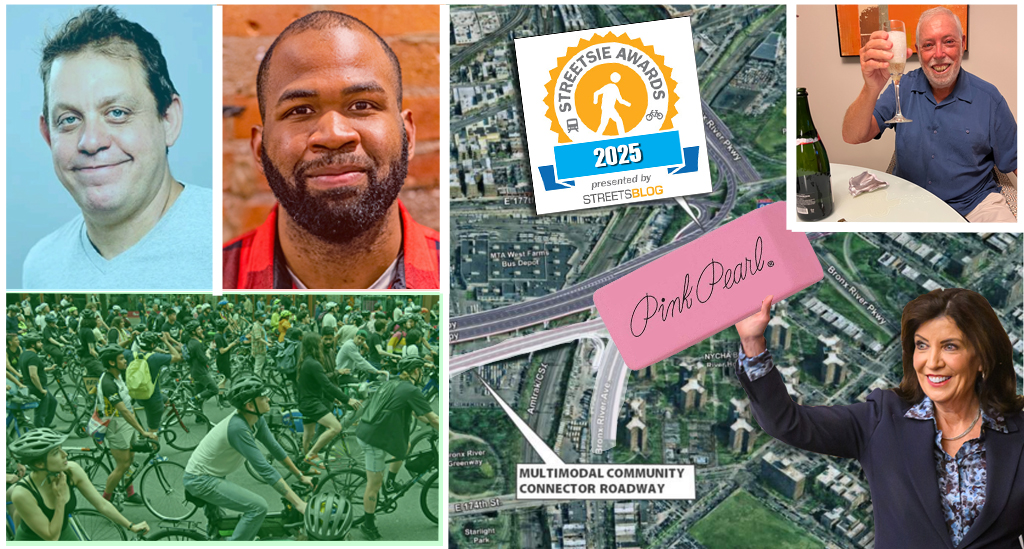With the election just days away, it’s a good time to reflect on what the Obama administration has done with transportation policy – and what a Romney administration might have in store. Streetsblog does not endorse candidates. This is an overview of their respective records and a look back at what we know of these two men. We’ll start with President Obama in this post and move on to Mitt Romney in the next one.
Perhaps the best thing President Obama did for transportation policy was to nominate Ray LaHood as U.S. DOT secretary. Sure, LaHood reportedly wanted to be Secretary of Agriculture, not transportation. And yes, Obama’s main motive for nominating the moderate Republican congressman was to make friends across the aisle, a goal that for the most part went woefully unmet. Nonetheless, LaHood has proven to be a genuine reformer.
We knew LaHood was a keeper when he stood on a tabletop and declared that bicycles were on an “equal footing” with cars, announcing “the end of favoring motorized transportation at the expense of non-motorized.”
The administration’s creation of the Partnership for Sustainable Communities has created valuable new links between federal transportation, housing, and environmental policies, demonstrating how government can eliminate barriers between agencies. It’s a model that some state transportation agencies have begun to take note of, as they approach local governments to craft land use and transportation decisions that make sense in tandem.
Even the Republican House of Representatives’ ire toward the Partnership can’t destroy the essential piece of it: that agencies are breaking down siloes and communicating more effectively with each other. The smart growth ethic that infuses the Partnership has permeated the three agencies involved – and many more.
Another signature achievement of this administration has been the TIGER program. TIGER has awarded more than $3 billion to more than 200 transportation projects based on their ability to meet strategic objectives, bucking longstanding policies (which continue in the current transportation bill) that fund transportation based on formulas and a singular focus on making sure every state gets their piece of the pie. While TIGER has some geographic criteria and a set-aside for rural areas, it has rewarded cities, regions, and towns that are innovating, and the program has prioritized bike/ped infrastructure, streetcars, freight rail, maintenance of existing roads, and other measures that advance sustainable transportation and smart growth. And by the way, that rural set-aside isn’t a bad thing: It’s helped jump-start transit access in a lot of small towns and tribal areas.
You can’t talk about the Obama administration's “signature” accomplishments without mentioning high-speed rail, which could have been the president’s crowning achievement. He swung for the fences and ended up hitting a single. The program now focuses on rail improvements, rather than HSR per se, which isn’t necessarily a bad thing. The confluence of the sour economy, bitter Congress, and stubbornly anti-rail governors was too much to implement the full extent of the administration's vision. High-speed rail is now being kept on life-support only because Congress can’t pass a budget and keeps extending old ones.
The high-speed rail program and TIGER both had their genesis in the stimulus bill, one of the monumental acts on which Obama’s administration is judged. But the stimulus was a one-shot affair, and it didn't change the core transportation policies that shortchange transit and lead so many states to waste billions of dollars on expanding highways.
The president did put forward an ambitious transportation bill that looked like a step in the right direction. It would have spent $556 billion over six years (compare that to the current bill: $105 billion over two years) with a bigger share for transit than in the current law. That bill, as well as his failed jobs bill, included seed money for a national infrastructure bank – another unfulfilled priority.
But the administration’s unwillingness to engage with Congress to find a viable revenue stream doomed Obama’s transportation proposal. The White House refused to get behind any funding source for the plan, whether it be an increase in the gas tax or a vehicle-miles-traveled user fee. That same issue jammed up negotiations in Congress as well, with the House unable to pass a bill at all until it finally approved the conference report. As the two chambers were embroiled in the process, it was hard not to notice the lack of leadership from the White House.
So maybe that’s the story of Obama’s presidency, when it comes to transportation: big ideas, not enough follow-through.
Rep. Jim Oberstar, the former House Transportation and Infrastructure Committee chair who was ousted in the midterm election, still remembers with no small amount of bitterness that the same reticence on funding issues resulted in the sidelining of his own transportation proposal, released three full years before MAP-21 was finally signed. In 2008 and 2009, when Democrats controlled both houses of Congress and the White House, the best chance to enact a robust bill came and went. Coming on the heels of the Wall Street meltdown and the foreclosure crisis, the price tag was deemed too high, and the political appetite for tax increases was too low.
Transportation and infrastructure haven’t come up much during this campaign. The Democratic platform is all GM bailout and new highways. Supporters of transportation reform have been left to pine for the days when Obama campaigned on a message of urbanism and transit.






